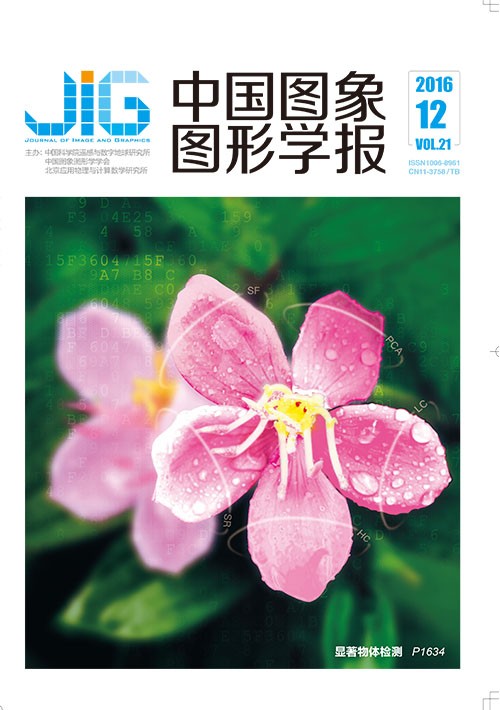
面向线阵列CCD道路影像的裂缝识别
摘 要
目的 道路裂缝的等级评定是公路养护的基本任务之一,目前国内相关部门主要通过线阵列相机采集道路影像,由于道路影像裂缝的识别会受到多种因素干扰(树木及车辆的投影、光照变化、油渍、树枝与稻草等条状物、各类垃圾),降低了基于道路影像自动识别裂缝算法的准确率,导致对于路面等级评价依旧采用人工的方式进行,为此提出一种道路影像裂缝鲁棒识别方法。方法 由于采集的图像尺寸较大,同时为了避免光照不均匀带来的问题,首先对图像进行分块,采用改进的CV模型对分块影像进行预处理,获得初步的分割结果。其次,通过以下4个特点识别线阵列CCD道路影像的裂缝:1)裂缝在分块区域中占据较小的面积比;2)裂缝在影像中呈现的连续性较差;3)裂缝的宽度与长度比值较小;4)同一段裂缝的走向基本一致。为了利用裂缝的后两项特点,采用椭圆拟合的方法计算初步分割区域的方向,并以此为基础将这些区域分为4类。在每个分类中,分别计算各区域内的质心位置,建立质心间的矢量表,设计递归算法计算其共线性,获得裂缝检测结果,并以此为基础构造活动模型的初始距离矩阵,通过在原图中迭代求解更为精确的裂缝区域。结果 从2 000幅道路影像中挑选包含道路裂缝的影像100幅,并按序号等间隔分别取出5组未含有裂缝的影像100幅,每组200幅组成数据集进行测试,采用分类指标统计的方法评测本文算法性能,在正确率、灵敏度、特效度、精度上均达到95%以上,道路裂缝的检测与提取时间约为1 min。结论 该方法不仅可以有效地识别裂缝,同时可以克服了环境中多种因素的干扰,误识别率较低,具有较高的实际应用价值。
关键词
Pavement crack detection algorithm for linear array CCD images
Jia Di1, Song Weidong2, Dai Jiguang2, Zhu Hong2(1.School of Electronic and Information Engineering Liaoing Technical University, Huludao 125105, China;2.School of Geomatics, Liaoing Technical University, Fuxin 123000, China) Abstract
Objective Grade evaluation of road cracks is one of the basic tasks in highway maintenance. At present, line array camera is mainly used for road image acquisition by relevant departments. Given that the recognition of road crack image is affected by many factors (such as projection of trees and vehicles, illumination changes, grease, branches and straw, and various types of garbage), the accuracy of the automatic identification of crack is reduced. Thus, an artificial method is always used to evaluate the road grade. In this paper, a new method of identifying the road crack image is proposed. Method Given the large size of the collected image and problem posed by uneven illumination, the image is initially divided into many blocks, and pretreatment with CV model is used to process each block to obtain preliminary segmentation results. Cracks of linear array CCD images are identified by the following features:1) cracks occupy a small portion of the patch,2) cracks have poor continuity in these images, 3) the ratio of crack width to length is small, and 4) the same trends of cracks are basically consistent. To employ the last two characteristics, we use ellipse fitting method in calculating the direction of the preliminary test results, and these areas are divided into four categories. In each category, the location of the center of mass for each region is calculated, and a vector table between the center of mass tables is established. A recursive algorithm is designed to calculate the collinearity, and crack-detection results are obtained. The accurate cracks are obtained by iteratively solving in the original image. Result A total of 100 images containing road cracks are selected from 2 000 road images. According to the serial numbers, 5 groups at equal intervals are taken out of the images that contain no cracks. Thus, the data sets are constructed with these 200 images in each group. The performance of the algorithm is evaluated by the method of classification index statistics. True positives, false positives, false negatives, and true negatives reached more than 95%, and the execution time of road crack detection and extraction is approximately 1 minute. Conclusion Experimental results show that the algorithm not only can identify the cracks effectively but can also overcome the negative interference of various factors. Thus, this algorithm has potential for practical implementation.
Keywords
|



 中国图象图形学报 │ 京ICP备05080539号-4 │ 本系统由
中国图象图形学报 │ 京ICP备05080539号-4 │ 本系统由